

Posted by Wayne Parham [ 65.69.121.77 ] on February 01, 2005 at 07:49:05:
The winds of change have blown through. The last Studio Series speaker with the KSN1038 tweeter shipped yesterday. From this day on, there will never be another one like it.
We've made improved models, so this doesn't signal the end of Studio Series π Speakers. But it does mark the end of an era. There was a consistency defined by those speakers. Like the bass unit shape of the π cornerhorn, the Studio Series was virtually unchanged for many years.
I can visit people's homes today and find a one π loudspeaker built in 1978 that looks almost exactly the same as one built in 1998. The pair of speakers that shipped yesterday look just like those too. After I saw "Star Wars" in the theater, I came home and probably listened to Todd Rundgren's "Ra" album on a pair of one π's just like those. Or maybe "Do You Feel Like We Do" from "Frampton Comes Alive." Remember those days?
Before I describe the new model, I'd like to reminisce and talk about the history of these speakers one last time. Then we'll move forward, and hopefully enjoy a few decades of music from the new models. I like things that are consistent, and Vifa assures me that the new tweeter will be available as long as there is a demand. So I feel comfortable that we'll be able to maintain consistency for many years with them, just like we did with the original models.
"Once upon a time, a long time ago," I wanted to build a pair of speakers that would sound really great with a budget of only about twenty bucks. That made small-format two-way "bookshelf" speakers in MDF cabinets a pretty attractive option. Using a bass-reflex cabinet and a good 8" or 10" midwoofer, I could get smooth, deep bass response in a fairly small box. I tried woofers from Eminence, CTS, Rockwell, Polydax and others. For a while, I prefered Rockwell 8" and 10" speakers, and only used Eminence for larger models. But later I switched to Eminence 8" and 10" drivers and, where the budget was no object, I used the JBL 2115.
The tweeter was more of a problem. Eminence and Rockwell woofers were about ten or twelve dollars and had good response to about 4kHz. Efficiency was well above 90dB/W/M. So to get a tweeter to match was a problem. I could get 3" paper cone tweeters from a variety of manufacturers, but they generally didn't sound all that good. Polydax made some soft dome tweeters, as did others, but efficiency was too low. There were some really great super-tweeters, and I initially planned to use one of those. Ribbons and horns with small aluminum diaphragms were extremely capable at the highest frequencies, and they always impressed me with their sparkle. But they usually didn't go down very low, and they didn't handle much power. There were a few small and relatively inexpensive compression horn tweeters with phenolic diaphragms, but their response wasn't all that great. So I went through a lot of tweeters before I settled on he KSN1038.
I went back and forth between paper cone tweeters with first-order crossovers and super-tweeters with elaborate crossovers. Neither really did everything I wanted them to do, but I thought I'd probably find my best solution in one of those. The paper cone solution was a better fit budget-wise, since it was less expensive and less complicated to implement. But their sound was boring. Some of the super-tweeters were better sound-wise, but naturally they were a lot more expensive. And they always seemed to require more elaborate crossovers. Try to simplify the crossover and you'd screw up the response or smoke the tweeters with any power at all.
The first time I checked out a Motorola piezo, I hated it. My first sample was a KSN1005, and I thought it sounded terrible. I suppose if it were crossed over above 5kHz, it would probably be OK but they really have a bad peak at 5kHz. And they're ugly too, so I wrote them off almost immediately. When it was suggested that I try the KSN1038, I almost disregarded it.
But a sample KSN1038 tweeter was sent to me and it didn't look bad. That helped. And the KSN1038 really does sound much better than the KSN1005. The 5kHz peak is reduced so much that you can use the tweeter down to its lower cutoff. It is acceptable to use without a crossover. So the KSN1038 became attractive to me. It looked good, sounded good, could be used without a crossover, and was priced just right. I had found the happy medium that was perfect for the Studio Series speakers.
So that started a long legacy. I've made one π and two π speakers with that tweeter for many, many years. They've proven to be extremely durable and good sounding for all these years.

Now we start a new legacy. The search for a new tweeter was a little bit like the last time. There are more components to choose from, but some of the same old tradeoffs still exist. But there are a handful of parts that presented themselves, each with their own strengths and weakneses.
I finally settled on the Vifa DX25. It offers very smooth response with high efficiency. It handles power very well and sounds unstrained, even at high volume levels. And it is an attractive part that gives the one π, two π and two π tower speakers a sophisticated look.
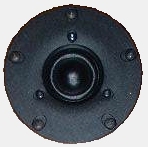
I personally own two pairs of speakers with the KSN1038 tweeters, and I am very happy with them. But I also own a pair of speakers with the new DX25 tweeter, and I've listened to them quite a lot in the past several months. Voices and the timbre of some intruments is smoother. It is not a night and day difference, more like the difference between a 12 year old scotch and a 15 year old scotch. But the DX25 is a little more refined and goes a little deeper into the midrange, so it makes the transition smoother.
I was able to implement the tweeter with a simple first-order crossover, which lends itself well to designs like this. This tweeter has a very wide surround and can handle low frequency energies very well, so it is a natural for a first-order filter. You can see from the response curve below that the transition from woofer to tweeter is seamless and that summing is good. The tweeter has slightly less output than the midwoofer, and the combination is very natural sounding.
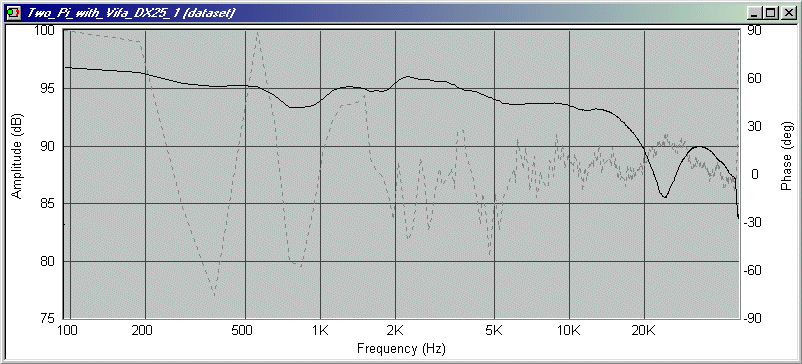
I like a speaker that blends within a foot or two, and where you just can't tell what part of the sound comes from what part of the speaker. I want a speaker that lets me listen to the music instead of listening to the speaker. This does that. It just makes good music.
Of course, the cost is higher. The DX25 tweeter costs about four times as much as the KSN1038, and it requires a large crossover capacitor. I also put a damping resistor across the tweeter. The resistance value is high enough that there is very little effect on impedance, but the models show a significant improvement in damping of the voice coil and crossover capacitor. So the cost of the kits has been increased to include these higher costs of components.
We're not talking about breaking the bank though. It amounts to a $20.00 increase, which isn't too bad for what you get. For a limited time, we're offering an upgrade kit for $30.00 to anyone that is interested. The kit includes a DX25 tweeter, 10uF polypropylene crossover capacitor, 16 ohm damping resistor and two 0.110" spade lugs. You'll need those because the connector size is different.
If you plan to add the Vifa tweeter, here's what's involved in the retrofit. First, remove the tweeter and using a round file or four-in-hand, ream out the tweeter hole just a tiny bit so that the DX25 magnet passes through easily. It doesn't take much, just a few swipes with the file, maybe 5 minutes work. Then use a 1/4" drill bit, enlarge the top two mounting holes that were used for the original KSN1038 tweeter. This allows the DX25 connectors to pass through. Clean and shape the holes with your file so that the tweeter slides easily into the hole and can be mounted flush. Fill the bottom two original tweeter mounting holes with wood glue so there is no leak.
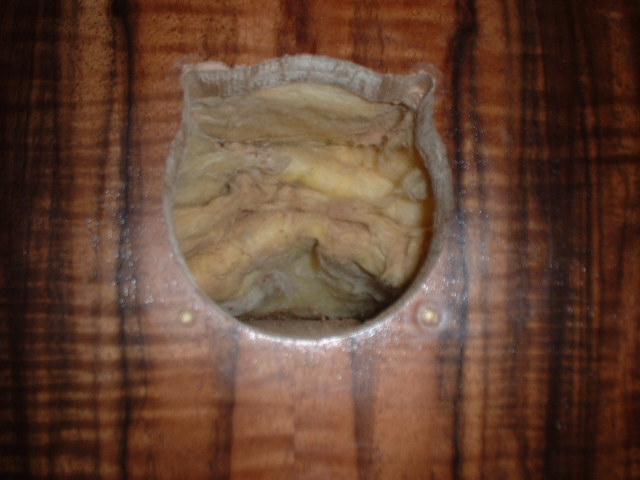
Then solder in the 10uF capacitor inline, and put the 16 ohm resistor across the connectors. You'll need to replace the existing 0.205" spade lugs with 0.110" lugs for the tweeter, so you can swap those when you install the resistor. I prefer to use terminals made for 14-16 guage wire and solder them instead of crimping them.
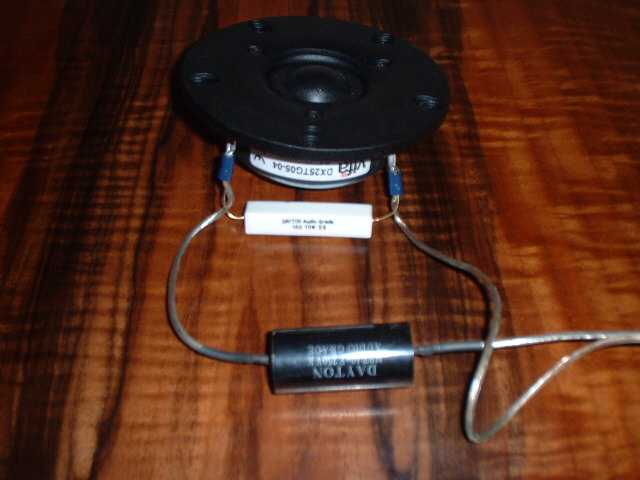
When you're done, the speaker will look like this:
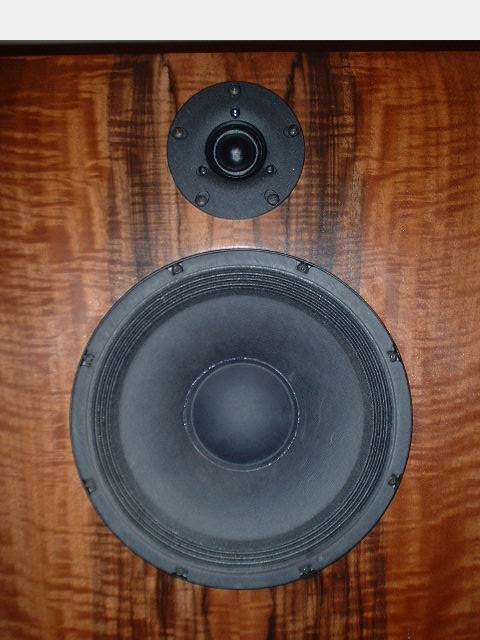
[ PiSpeakers Forum ] [ Help ]